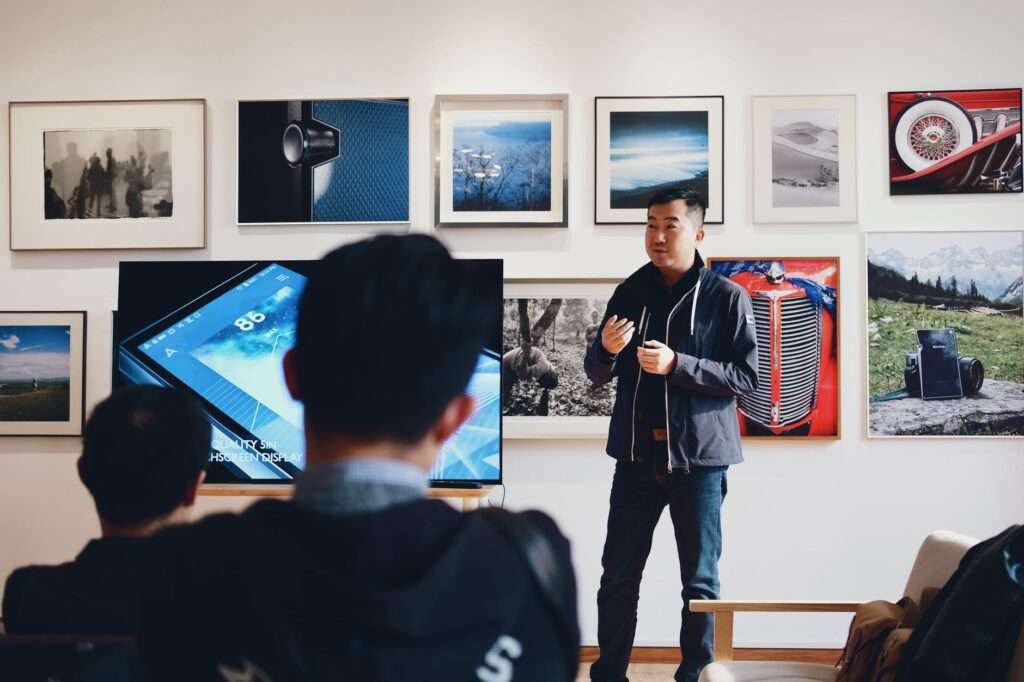No one has the innate ability to Public Speaking. The art of speaking in public must be learned. In this article, I’ll show you how to keep improving performance. Presentations at school, speeches at student conferences, defense of diplomas, talking about applying for a job yourself, each of you has the experience of speaking in public. You can also understand presentation logic, visual comfort, and how important a correct presentation is. Dozens of books, courses, and training are dedicated to each of these three public speaking whales. How do you implement many useful tips?
We recommend that you consistently work on all aspects of public speaking and use the tools currently available for video recording.
1. Make a video of your presentation.
Great if you have a video of your last live performance. Even if this is a short piece that clearly shows you and at least some listeners, such a recording is very helpful to get started. If you don’t have a shot, it’s time to take it during your next performance rehearsal! The closer the conditions under which the video is created, the more effective the subsequent analysis. If you’re not going to play it easily but want to “strengthen” this skill right now, first record a short 1-2-minute monologue on the topic you’re interested in. Get used to the camera, feel the timing, and practice various intonations.
2. Prepare a notebook or tablet on your computer to record the results of your speech analysis. You can start with two columns, “good” and “correct.”
3. Watch the video several times, focusing on one aspect of the presentation each time. It’s hard to watch my video well. Be patient, think about how good your next performance will be, and start your analysis!
When you first see it, pay attention to the logic and accessibility of your presentation. Did you inform the audience of the purpose of the speech? Did you clearly explain your point? Is there a logic violation in your story? Did you meet the deadline, or were you wrinkled at the end of the show? In the second ad, analyze your feed. How do you say? Is it clear enough at a loud volume? Does your speech match the topic of your speech? Did you avoid the word parasite? How do you hold up? Do you walk or stand, look at the audience, look at the slides, smile, or get nervous with fear? If you have enough energy for your third sighting, you can concentrate on analyzing your interaction with the audience. Did you get the attention of the audience? Do you have any questions for them? Does the audience react to your jokes? Of course, casual interaction with the audience is the ultimate eloquence. But we are confident that you will reach this aspect of performance!
4. Analyze the list. It is useful to have multiple entries in the “Good” column. Use these skills in the next conversation and build them as a foundation. The list of fixes can be very long, but don’t worry. Select 2-3 items from there. We encourage you to start improving performance from aspects related to structure and presentation. The lack of usefulness and meaning of the report cannot be replaced by good jokes and dialogues with the audience.
5. Consider your action plan and success criteria. After deciding what to work on, think about how to do it, and most importantly, what results in you think are sufficient. Add “What do I do?” Added. At your table. And “How do you understand that your goal has been achieved?” For example, you may find that most presentations look at slides rather than the audience. This means that during rehearsals and subsequent performances, you need to pay special attention to how you are standing and where you are looking. Your action plan looks like this: “Learn the order of the slides and the text of the story. Ask Fodor to interrupt the rehearsal as soon as I turn my back. During the performance, don’t forget to choose two people to talk to in the hall. Success is when you realize that you’ve been facing the viewer for more than half the time in the next video. If you decide to tackle the brevity and clarity of the explanation, you don’t need slides or speeches. Boldly remove the details, look for simple examples that explain your thoughts, and ask your colleagues to listen. Ambitious to establish a reputation as someone who knows how to articulate complex things. You shouldn’t set goals right away. Let’s start with a simple standard. “At the end of the speech, one of the listeners said:” Thank you, I finally understand everything. “”
6. Find a companion who also wants to improve the quality of his public speaking. Friendly support, feedback, technical help, collaborative thinking, and finding solutions go far beyond this path alone.
7. Finally, practice, practice, and practice further. Take full advantage of your speaking opportunities, as skills only manifest themselves over and over again. Draw and analyze results regularly. Celebrate what you have achieved and use it in future conversations. Address the gap by setting concrete and achievable goals for the next conversation. You will see, progress will not belong to come!
